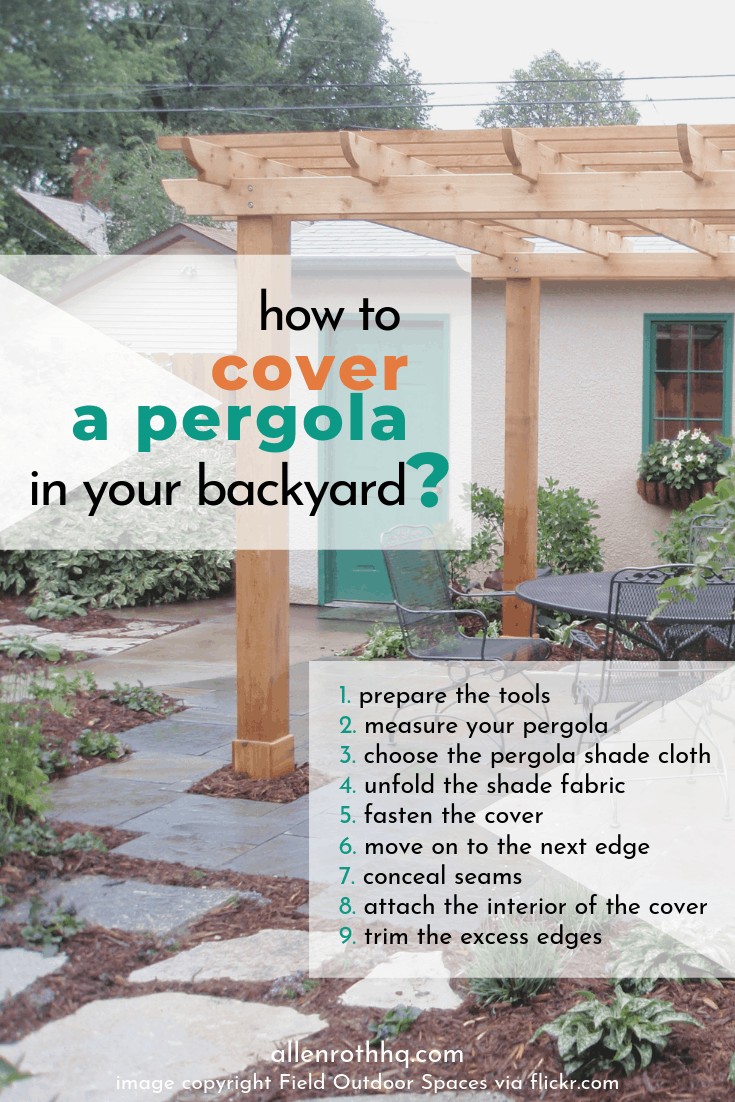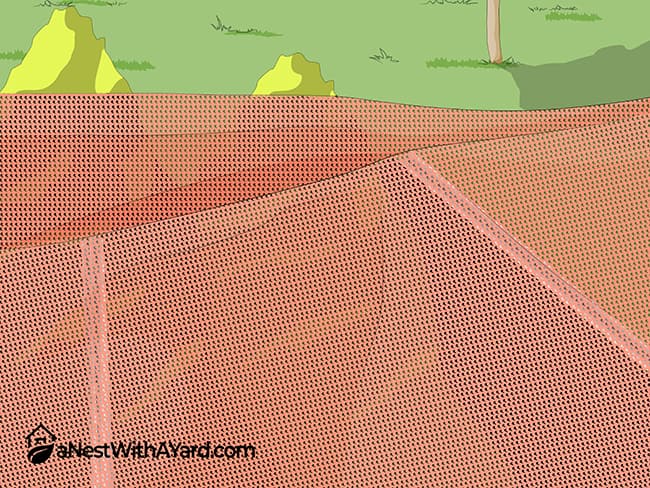Everyone who owns a yard dreams of turning it into a cozy relaxation spot, either from some quality alone time or for getting the family together for some games and giggles.
Whatever the reason, putting a pergola in your backyard is always a great idea. But how can you really enjoy this structure to the fullest when the harsh summer temperatures are unbearable?
Is there any way to shield this pergola-gem from the sun? The answer is yes and I’m going to show you how to cover a pergola without spending a fortune.
Don’t get me wrong, I love hiring contractors to do the work for me as much as the next person, but sometimes I feel overcharged for tasks that seem rather simple. So, I tackled the idea of making and installing my pergola covers myself. In the process, I discovered that the process is easy, inexpensive, and doesn’t take too much time. Let’s get started!
Contents
What You’ll Need
Chances are you already have most of the tools you need for this project around the house. What you probably don’t have is some pergola shade cloth, but I’ll come back later with a few good pergola shade cloth ideas. That being said, you’ll want to make sure you have:
- A ladder — It should be at least the height of your pergola, so you can easily gain quick canopy access
- A ruler/a level
- Measuring tape
- A cutter/sharp scissors
- Hammer/screwdriver
- Fasteners — You can use screws, nails, or wood staples
- Safety equipment — Safety glasses, gloves, and maybe a safety helmet, since you’ll be working on top of a ladder
- Pen and paper
Step-by-Step Instructions on How to Cover a Pergola
Steps
Here’s a step-by-step guide on how you can cover a pergola properly:
- Preparing The Tools
Since a great part of this project requires you to be at the top of a ladder, you’ll need a system that allows you to have all the tools you need up there with you. This will help you avoid making multiple trips up and down the ladder.
If you don’t have a tool belt, you can use something like a fanny pack to hold all the nails, screws, and other small things you’ll need for this project. Otherwise, you should ask someone to assist you while you set up the cover, by handing you whatever items you need along the way.
- Measuring The Pergola
This step is very important. You don’t want to waste money by buying too much fabric and you want to make sure you have enough to cover your entire pergola.
You’ll need to grab a measuring tape and measure the lengths of each of the four sides of the pergola roof. Write these measurements down on a piece of paper – you’ll need them later.
If you’re having some trouble measuring your pergola, there’s a quick video guide that will help you down below. - Choosing Your Pergola Shade Cloth
Before you buy anything, you need to do your homework to know exactly what you’re spending money on. Good pergola shade fabric should meet a few requirements in order to give you the comfort you need:
● It should be breathable so that it doesn’t trap heat inside.
● It should block out UV rays.
● It should be resistant to shrinkage.
● If possible, it should be waterproof, so that you can sit underneath it when it rains.
● It should be easy to clean because it will be exposed constantly to dust and debris.
Also, make sure that the outdoor fabric for the pergola roof you buy is larger than the pergola’s canopy because it’s better to cut away excess material than to leave parts of the roof uncovered.
- Unfold The Pergola Shade Fabric
Position the ladder in a safe spot that grants you access to as much of the pergola’s roof as possible, so you can unfold the fabric or cover over the entire surface of the canopy.
Make sure there is extra material hanging over all the sides, so you can secure it to the roof later on. Leave the fabric loose, making sure there is about one foot of fabric hanging over each of the canopy’s edges. - Fastening The Cover
Move to one of the pergola’s sides, so you can start attaching the cover to the canopy. You can use whatever fasteners you have on hand, including construction staples, wooden screws, or galvanized nails.
Leave about 12 to 16 inches of space between each of the fasteners, while always making sure that the cloth’s weave is parallel to the pergola frame. This will give consistency to your cover, creating a pleasant look that can be seen when standing underneath the material.
Every time you attach a new fastener, make sure that the fabric is tight enough as not to create any wrinkles in the fabric. Also, make sure it’s not too tight, or the fasteners might be put too much pressure on the fabric, causing it to tear.
Leave some space between the fasteners and the edge of the pergola, as you will need to cut the excess fabric later. - Move On To The Next Edge
When you’ve finished with one side of the frame, you can continue on to the next edge, moving along the perimeter of the canopy. Make sure that you pull the fabric gently before putting each fastener in place. - Concealing Seams Or Two Pieces Of Pergola Shade Fabric (Optional)
If your pergola roof is big and you need more than one piece of fabric, make sure to hide the seams or where the two pieces meet, or else the project will look sloppy. To do this, conceal the bind between the two pieces with a rafter inside the pergola. No one will see how the cover looks from above, but a rafter inside will hide where two pieces of fabric meet. - Attaching The Interior Of The Pergola Shade Fabric
When you’ve secured the cover to all four edges of the canopy, it’s time to move on to the interior sections.
This will add extra stability to the cover, just in case, the outside fasteners fail. Try to leave the same distance between the fasteners, while always pulling the fabric to make sure it’s smooth and tight, but not too tight. - Trim The Excess Edges
Now you should have all the fasteners in place and the fabric spread tightly over the roof of your pergola. In order to trim the excess pergola shade cloth, you should use a guide, to ensure a clean cut.
You can use a ruler or a level, but you can also use the bottom part of the edge as guidance if need be.
How To Measure A Retractable Canopy Video Guide
Here’s a video that will make measuring a canopy look easy:
How To Cover A Pergola Recap

Product Suggestions for Your Pergola Project
As promised, I want to give you a few pergola shade cloth ideas to help you on the right path. Naturally, you can always create your own pergola shade fabric, but that is mostly for people who have the extra time to take on one more DIY project.
If you’re short on time, any of the following products are a great option for your outdoor fabric for pergola roof.
In A Rush? Check Our Picks!
Let’s take a quick glance at the products we will talk about here.
Shatex Sun Shade Fabric
If you’re looking for a resistant sheet of mesh that can shield you from the sun, here is an option for you to cover your pergola. This product is made with high-density polyethylene, which can survive mold and mildew.
Furthermore, this cover features UV protection and it can block up to 90% of the sun’s rays, keeping you cool in the shade. The fabric is created to be breathable, so you’re not sweating underneath it like you’re inside an oven.
One single sheet is 8×16 feet in size, but you can easily trim it to the dimensions of your choice, thanks to the raw edge. Mounting this cover is easy: just staple the fabric to the top of the pergola and you’re good to go.
PROS
- Blocks 90% of the sun’s rays.
- Resistant to mold and mildew.
- Easy to trim for your personal needs.
- Breathable to allow airflow for good ventilation.
- Made from recyclable material.
- Resistant to wear and tear.
CONS
- Not true to its size.
- No multiple color options available.
Gale Pacific Knitted Shade Fabric
Available in heritage green, grey, and wheat, the Gale Pacific pergola cover is made from the same type of high-density polyethylene as the above product. However, it features fine knitted details that make the fabric more breathable than similar items.
With this option, you also have more color versatility, which is nice. The heritage green is a great choice for people who want a more natural look to their pergola.
The material is easy to clean and spraying it down with a hose should do the trick. Its weather resistance is also something to be noted because nature’s elements (such as sun or frost) can easily deteriorate a lower-quality product.
Aside from these benefits, this fabric also offers protection from the sun. The material can block out 84-90% of the sun’s rays, giving you a shady spot for you to enjoy your summer afternoons.
One sheet of fabric measures 6×15 feet, but you can trim it to best fit your pergola.
PROS
- 84-90% sunlight blockage.
- Durable knitted fabric.
- Breathable weave.
- Resistant to mold and mildew.
- Available in three different colors.
- Easy to clean.
- Resistant to nature’s elements.
CONS
- Not as breathable for those living in a very humid environment.
- Cutting the edges curls the fabric.
Patio Paradise Shade Cloth
Here is yet another great example of a cloth choice for people who want to cover their pergola. This shade cloth maximizes shade and creates an intimate and cool ambiance during hot days.
You can choose from a multitude of sheet sizes, plus four pleasant colors to best match your current yard decor — yellow, turquoise, brown, and beige.
You can expect to get the same benefits as with the other two aforementioned cover options, as this one is also made from high-density polyethylene. The knit material makes for increased breathability and prevents a suffocating environment under the cover.
Besides shielding you from UV radiation, this cover is efficient at resisting mold and mildew. It also maintains its shape and size, even after prolonged hours in the sunlight.
PROS
- Highly breathable.
- Good for multiple applications.
- Efficient in blocking out sunlight.
- Four color options available.
- Multiple sizes available.
- Can block up to 95% of UV rays.
CONS
- Doesn’t have sewn borders.
- Not very tear-resistant.
- Not waterproof.
Conclusion
It’s important to know how to cover a pergola yourself because hiring a professional for this rather simple task can cost you a lot of money. But, besides the money-saving factor, it’s nice to contribute to something using your own two hands.
If you found this tutorial useful and would like to read more of these types of articles, let me know in the comments. What future DIY home project sparks your interest?
Last update on 2024-04-18 at 06:02 / Affiliate links / Images from Amazon Product Advertising API







